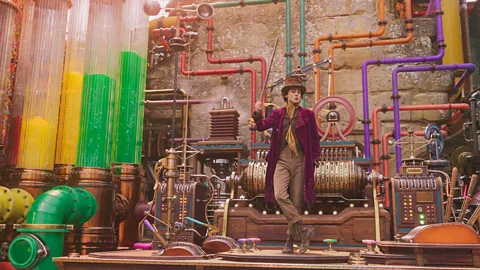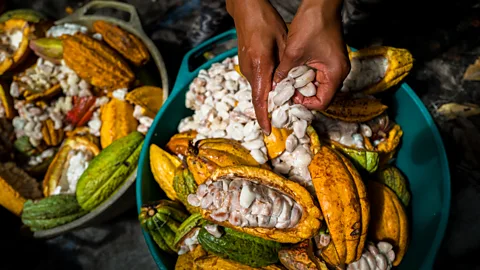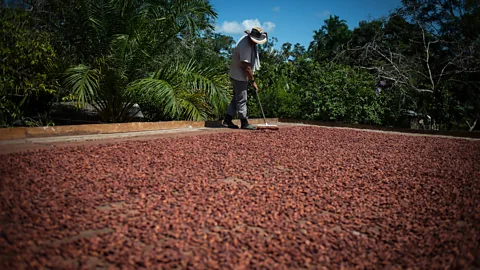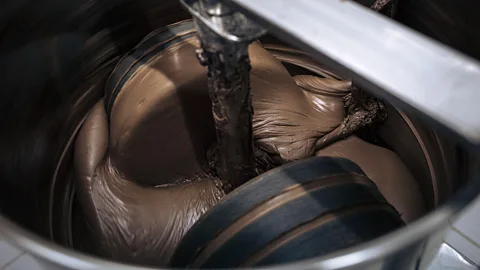The real-life Willy Wonkas trying to change chocolate
 Warner Bros
Warner BrosPlaying with the taste of chocolate to create unique flavour experiences led to fame and fortune in the fictional world of Wonka. Now scientists are finding ways of doing it for real.
A flute slowly ascends a scale, a gentle vibrato rounding out the notes. The warm, resonant sound contrasts sharply with the next recording. In this one, a violin is plucked in a dissonant pizzicato, with no reverberation to soften it. "It's tense," says Felipe Reinoso-Carvalho, a sound-engineer-turned-scientist who created the tracks. Each of these clips possesses a surprising power, he has discovered. They can change the taste of chocolate.
Chocolate is an iconic eatable. Since confectioners invented bar chocolate about 180 years ago, it's captured the imagination of billions around the globe, though it's a simple enough recipe. Take the fermented, roasted beans of the cacao tree, grind the kernels to a paste, heat it and mix it with sugar, cocoa butter, and perhaps milk, and let cool it into the shape of your desire.
Endless variations on this theme have leapt from the fertile minds of chocolatiers. Some are mainly manipulations of the human psyche, like the Kinder Egg, replete with the mystery of the toy hidden within, an invention that celebrates its 50th anniversary in 2024. Other makers have leaned into the sweet's botanical origins. Brazilian chocolatier Luisa Abrams creates her highly unusual small-batch bars using wild cacao from the Amazon, working with locals who collect the bulbous yellow fruit by canoe.
Either way, lowbrow or high, we can't get enough of the stuff. People in the US get through 9kg (20lb) of the stuff a year on average, making them the second biggest chocolate eaters in the world behind Switzerland, where they gobble down nearly 12kg (26lb) a year. In the UK, by comparison, the average person eats 3kg (7lb) a year. (Oddly enough, scientists have found a statistical correlation between chocolate consumption by a country and the number of Nobel Prizes winners it has, even after controlling for wealth.)
Scientists like Reinoso-Carvalho, who now studies sensory marketing at the Universidad de los Andes School of Management in Bogotá, Colombia, are uncovering new ways to heighten the chocolate experience. Some researchers, delving into the pulpy heaps of fermenting cacao beans, are documenting the bacteria that control chocolate's flavour to understand which microorganisms are responsible for what tasting notes. Others are peering into the cacao tree's genetics to see whether breeding can bring out new features of interest to farmers and consumers. What these real-life Willy Wonkas find may shape the future of chocolate. ("Relentlessly wacky and over the top": Find out what our critics thought of the new Wonka film.)
 Getty Images
Getty ImagesReinosa-Carvalho's own interest in how sound can shape taste was sparked by the work of Charles Spence, an experimental psychologist at the University of Oxford who studies how our senses beyond taste and smell affect our experience of food, and once found that hearing the crunch of crisps makes them more enjoyable. When he and Spence decided to collaborate, chocolate was a natural choice, because Reinosa-Carvalho was living in Belgium. "You can go deep with chocolate characteristics there," he says, citing a wide array of high-end chocolate makers willing to experiment. For this study, the scientists worked with Dominique Persoone, head of The Chocolate Line, a renowned chocolate shop in Bruges, Belgium. They wanted to know if sound could make chocolate seem creamier, without altering the confection's makeup at all.
The Chocolate Line made a series of dark chocolates with two levels of cacao, 71% and 80%. The formulas had no cream or milk. Each type was made in two shapes, a smooth, rounded dome and an angular, cut-gem shape. Then, Reinosa-Carvalho used music from a sound library to create two minute-long tracks that people would listen to as they ate. By giving participants different combinations of chocolate shape, formula, and sound, and then asking them to rate the sweet's creaminess, they could see whether the sound changed the eating experience.
"The results were amazing," says Reinosa-Carvalho. "More than the shape and the cocoa, the music affected the taste." The flute made the chocolate, whatever its shape and formula, seem both sweeter and creamier. The dissonant, pizzicato violin yielded ratings that were less creamy and more bitter. The alteration was not massive – on a seven-point scale, they could achieve a one-point difference – but it was extremely consistent.
We like to think of taste and flavour as being inherent in the thing we're eating. But the truth is that taste is in the brain of the eater. Change what the brain is experiencing, and you can alter something quite fundamental.
A thriving population of microbes, long gone by the time a bar reaches consumers, is also crucial to chocolate's taste. Cacao farmers break open the massive pods and scrape the goopy white insides, studded with cacao beans, into wooden boxes, or pile them into heaps. Then they let them ferment until the beans have turned from a pale colour to a reddish-brown colour when sliced open.
If you try to make chocolate from unfermented beans, you'll be disappointed. "Flat" and "muddy" are two words that Martyn O'Dare, co-founder of Firetree Chocolates, uses to describe the taste. Alexander J Taylor, a food microbiologist at the University of Illinois, Urbana-Champagne, has a piquant thought experiment for curious consumers: "If you've tasted 100% cacao, it's very bitter. Imagine that but 10, 30, 50 times worse, depending on the beans."
So, what is going on while the beans are fermenting? For fine cacao, used by high-end craft manufacturers, fermentation lasts about six days, says O'Dare. This process of controlled decomposition is seeded by microbes from the farmers' hands, from the soil and from the plant itself. They may even come from the wooden boxes themselves, says Luisa Vicinanza-Bedi, the founder of Luisa's Vegan Chocolates. "If the box is brand new, it doesn't give such a good end finish," she says. "It has to be old, so the [microbes] are already there on the box."
Yeasts kick off the process, then the bacteria get moving. At first, anaerobic bacteria – those that don't need oxygen to grow – are ascendant, says O'Dare. The wet pulp from inside the pods keeps oxygen away from the beans, meaning these bacteria thrive there. Then, as the pulp falls apart, aerobic bacteria take over around the second day. This leads to the fermentation becoming more acidic. Temperatures begin to rise, sending the microbes into a feeding frenzy. As the bacteria feed, they alter the biochemical composition of the beans, changing the texture and the internal colour, which moves through deep purple to rich brown. Enzymes break down some of the more bitter and astringent compounds while many of the proteins and sugars found in the raw beans also undergo transformations. All of this leads to the development of more than 600 different compounds – from alcohols to acids and bitter phenols – which contribute to the familiar aroma and flavour of chocolate.
But the process requires care – if the fermentation goes on too long, the beans develop an unpleasant hammy flavour. To avoid this, on day six, the fermentation is halted, either by rinsing the beans or putting them out to dry.
Controlling the temperature and acidity of this process is one way that scientists have found plays an important part in the quality of the cocoa that is produced. But the bacteria themselves are also key.
 Getty Images
Getty ImagesVicinanza-Bedi and O'Dare have worked with scientists at University of Nottingham who have documented the microbes on each day of fermentation on cacao farms in Colombia. The researchers have been using DNA sequencing to build up a library of the different bacteria and yeasts involved in the process. This work has not yet been published, but expert tasters tried sweets the chocolatiers made from each farm, and the scientists worked to correlate the tasting notes with the microbes found at each site.
Taylor has also been working with colleagues to better understand the different microbes involved in fermentation in different parts of the world. After reviewing the scientific literature of fermentation processes from 17 different countries, they have identified 447 unique species – including 147 yeasts, 45 acetic-acid-producing bacteria and 85 lactic-acid-producing bacteria. Studies across farms in Colombia, for example, have revealed a core set of bacterial and fungal species are needed for cacao fermentation, but differences appear to correlate to unique flavour profiles.
By better understanding what microbes are responsible for desirable or unusual flavours, it might be possible to encourage those to feature more in a particular chocolate. It could eventually lead to a situation where by carefully controlling the conditions in which beans are fermented and introducing particular microbial species, it will be possible to produce chocolate bursting with unusual flavours. And there might even someday be widely available starter cultures, the way there are for bread. "Whether that's a good or bad thing, I don't know. Like cheese, it's a debate," said O'Dare.
But there could also be more immediate benefits for cacao farmers themselves. They are often grindingly poor, so helping them to nurture the right microbes to avoid a fermentation failure would allow them to get a more consistent yield from their crops (although by itself it is unlikely to be enough and there is a push to get fairer pay from chocolate companies).
The genome of the lanky, glossy-leaved cacao tree holds other keys to chocolate's flavour. Mark Guiltinan, a cacao breeder at Pennsylvania State University, has worked to identify genes for metabolic enzymes and other proteins that control interesting traits in the tree. He and his colleagues are due to soon publish the genomes of 38 different trees. "These are very diverse cacaos," he said. "We have found all kinds of things in there."
It's clear that genetics matter: different cacao varieties can yield very unique flavours. The nacional variety, long grown in Ecuador but increasingly hard to find, gives a raisin-y, fruity taste, in Guiltinan's experience. The criollo variety from Central America, meanwhile, can taste nutty, he says.
You might also like:
There are about 3,000 different cacao trees whose seeds are saved in gene banks, Guiltinan estimates, including the results of expeditions to the Amazon, where cacao is native. But it can be very difficult for scientists to get to wild trees. Most collecting trips involve travelling by boat into the jungle and taking just a few steps into the forest before coming back with a pod. "What we think is that there is a lot out there that we still don't know about, out in the rainforest," he said.
 Getty Images
Getty ImagesWith more genetic sequencing and work to identify which genes do what, cacao breeders might someday be able to change what the final product tastes like. It takes time, but by crossing promising trees together, they could, say, ensure that there's more of a particular molecule for bacteria to work with. At the moment, breeders tend to focus on traits like resistance to disease, something cacao farmers struggle with.
Guiltinan would like to improve the lot of the people who produce the crop at the core of this most indulgent of sweets. Children often work on cacao farms, in dangerous conditions and carrying heavy loads. (In 2005, US Congress tried to get chocolate companies to commit to eliminating child labour from the supply chain, but were repeatedly brushed off.) What's more, the global chocolate market may be more than $238bn (£189bn), but little of that gets to the people who grow cacao. "The average farmer's income is $550 (£440) a year," Guiltinan said.
Breeding plants that require less labour to tend, or getting growers access to machinery that could help lift loads or open pods safely, are steps that could secure the global supply of chocolate by helping the people most crucial to its existence.
"That for me is the big push," Guiltinan said. Justice, after all, has a flavour all its own.
--
If you liked this story, sign up for The Essential List newsletter – a handpicked selection of features, videos and can't-miss news delivered to your inbox every Friday.
